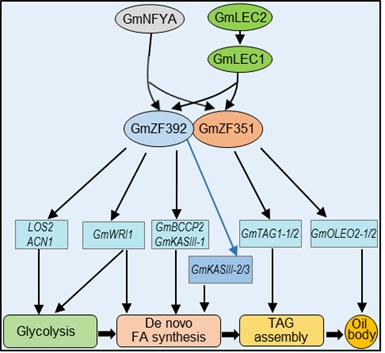A team led by Prof. ZHANG Jinsong from Institute of Genetics and Developmental Biology, Chinese Academy of Sciences has recently revealed a new transcriptional regulatory module enhancing lipid accumulation in soybean, which was published in New Phytologist (2021 Apr 17. DOI: 10.1111/nph.17401).
For years, researchers have been working hard to disclose the molecular mechanism of oil biosynthesis and accumulation in plants. While the fatty acid biosynthesis is well understood, the regulatory mechanism of this process during seed development is still unclear. ZHANG's group has found several transcription factors (TFs), which mainly play biological roles in developing soybean seeds. Overexpression of these TF genes would significantly increase oil content in soybean seeds.
In this study, researchers discovered that three of these TFs, GmZF392, GmZF351 and GmNFYA, formed a transcriptional regulatory module. The core part of this module consists of two tandem CCCH-type zinc-finger proteins (TZF), GmZF392 and GmZF351. The two TZF proteins can activate dozens of target genes related to plant lipid biosynthesis and accumulation, through recognizing their own binding elements in the promoter regions of these targets.
This regulatory mechanism functions in two ways. If the downstream genes possess the binding elements of both GmZF392 and GmZF351 in their promoters, the two TZF proteins would play additively roles in activating downstream genes. But for some target genes, only one kind of binding elements is found in their promoter regions. In this case, GmZF392 and GmZF351 form a transcriptional complex to synergistically activate gene expression. Either way could guarantee the participation of the two TZF proteins, so that the downstream genes are up-regulated by two TZF proteins to a much higher level than by only one of them. The third member of this module is a nuclear factor Y subunit, namely GmNFYA. GmNFYA acts as an upstream activator of GmZF392 and GmZF351 in direct and indirect manner respectively.
The GmNFYA-GmZF392-GmZF351 module promotes oil accumulation in soybean seeds very effectively, for it participates in the whole lipid biosynthesis pathway, including sugar transport, glycolysis, De novo fatty acid (FA) synthesis and lipid storage (triacylglycerols and oil body assembly) (Fig. 1). Besides, results also showed that the GmNFYA-GmZF392-GmZF351 module is connected with the TF network, known as the LAFL network originally found in Arabidopsis, for regulation of lipid accumulation.
The finding of this study greatly enriches our knowledge about the transcriptional regulatory network in plant lipid biosynthesis and accumulation, and should have potential benefits to the improvement of soybean oil production in practice.
Fig 1 The transcriptional regulatory module of GmNFYA-GmZF392-GmZF351 for oil accumulation in soybean (Image by IGDB)
Contact:
Dr. ZHANG Jinsong
Institute of Genetics and Developmental Biology, Chinese Academy of Sciences
 Fig 1 The transcriptional regulatory module of GmNFYA-GmZF392-GmZF351 for oil accumulation in soybean (Image by IGDB)Contact:Dr. ZHANG JinsongInstitute of Genetics and Developmental Biology, Chinese Academy of SciencesEmail: jszhang@genetics.ac.cn
Fig 1 The transcriptional regulatory module of GmNFYA-GmZF392-GmZF351 for oil accumulation in soybean (Image by IGDB)Contact:Dr. ZHANG JinsongInstitute of Genetics and Developmental Biology, Chinese Academy of SciencesEmail: jszhang@genetics.ac.cn CAS
CAS
 中文
中文




.png)
